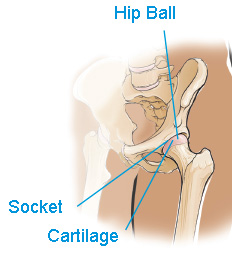
In a healthy hip, cartilage provides a cushion between the hip ball and socket.
 In an arthritic hip, the cartilage has thinned and deteriorated, allowing bone to rub against bone, causing pain.
In an arthritic hip, the cartilage has thinned and deteriorated, allowing bone to rub against bone, causing pain. Hips are a prime target for arthritis. The first sign may be an occasional ache, but, over time, the pain may become too much to ignore. Millions of Americans have more than 100 different types of arthritis, and osteoarthritis, the most common type, is a leading cause of hip pain. Joints like the hips are simply places where bones meet and join together. Those meeting places are cushioned by cartilage, so the bones don’t rub right up against each other. But when the cartilage is worn away—which is actually the definition of osteoarthritis—the result is a bone-on-bone grind. That grinding hurts. You can feel it walking, sitting, or even lying down trying to sleep. Other causes of hip pain include rheumatoid arthritis, osteonecrosis (death of bone caused by insufficient blood supply), injury, and bone tumors.
Diagnosis
Early diagnosis of arthritis and tailored treatment are crucial in slowing or preventing damage to your joints. Only a physician can determine if you have arthritis, based on:
- the overall pattern of symptoms
- medical history
- physical exam
- X-rays and other imaging techniques
- lab tests
